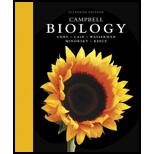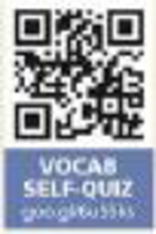
Concept explainers
Sensory receptors transduce stimulus energy and transmit signals to the central nervous system (pp. 1106-1 110)

n The detection of a stimulus precedes sensory transduction, the change in the membrane potential of a sensory receptor in response to a stimulus. The resulting receptor potential controls transmission of action potentials to the CNS, where sensory information is integrated to generate perceptions. The frequency of action potentials in an axon and the number of axons activated determine stimulus strength. The identity of the axon carrying the signal encodes the nature or quality of the stimulus.
n Mechanoreceptors respond to stimuli such as pressure, touch, stretch, motion, and sound. Chemoreceptors detect either total solute concentrations or specific molecules.
To simplify sensory receptor classification, why might it make sense to eliminate nociceptors as a distinct class?
To determine: The reason why it makes sense to classify nociceptors as a distinct class of sensory receptors.
Introduction:
Nociceptors are the sensory receptors that respond to threat stimuli. They are also called pain receptors because they sense any threat to the body and then alarm the brain and spinal cord. They are free nerve endings of a sensory neuron, and they are found in every tissue. When the electric current generated by the neurons reaches above the threshold value, nociceptors get activated and send signals to the central nervous system.
Explanation of Solution
In response to any kind of threat or pain, sensory neurons transmit the signals to interneurons in the spinal cord for the integration of these signals. Substance P is the neurotransmitter that stimulates the interneurons, which carry the signals to the spinal cord. The spinal cord then sends the signals to the brain and the thalamus and the perception of the pain starts. The nociceptors are similar with the other classes of receptors by the kind of stimulus they recognize but are different from the other classes of receptors in the way they recognize the stimulus. Hence, it creates a sense to “eliminate nociceptors as a distinct class of receptors”.
Want to see more full solutions like this?
Chapter 50 Solutions
Campbell Biology (11th Edition)
- In one paragraph show how atoms and they're structure are related to the structure of dna and proteins. Talk about what atoms are. what they're made of, why chemical bonding is important to DNA?arrow_forwardWhat are the structure and properties of atoms and chemical bonds (especially how they relate to DNA and proteins).arrow_forwardThe Sentinel Cell: Nature’s Answer to Cancer?arrow_forward
- Molecular Biology Question You are working to characterize a novel protein in mice. Analysis shows that high levels of the primary transcript that codes for this protein are found in tissue from the brain, muscle, liver, and pancreas. However, an antibody that recognizes the C-terminal portion of the protein indicates that the protein is present in brain, muscle, and liver, but not in the pancreas. What is the most likely explanation for this result?arrow_forwardMolecular Biology Explain/discuss how “slow stop” and “quick/fast stop” mutants wereused to identify different protein involved in DNA replication in E. coli.arrow_forwardMolecular Biology Question A gene that codes for a protein was removed from a eukaryotic cell and inserted into a prokaryotic cell. Although the gene was successfully transcribed and translated, it produced a different protein than it produced in the eukaryotic cell. What is the most likely explanation?arrow_forward
- Molecular Biology LIST three characteristics of origins of replicationarrow_forwardMolecular Biology Question Please help. Thank you For E coli DNA polymerase III, give the structure and function of the b-clamp sub-complex. Describe how the structure of this sub-complex is important for it’s function.arrow_forwardMolecular Biology LIST three characteristics of DNA Polymerasesarrow_forward
 Human Biology (MindTap Course List)BiologyISBN:9781305112100Author:Cecie Starr, Beverly McMillanPublisher:Cengage Learning
Human Biology (MindTap Course List)BiologyISBN:9781305112100Author:Cecie Starr, Beverly McMillanPublisher:Cengage Learning Human Physiology: From Cells to Systems (MindTap ...BiologyISBN:9781285866932Author:Lauralee SherwoodPublisher:Cengage Learning
Human Physiology: From Cells to Systems (MindTap ...BiologyISBN:9781285866932Author:Lauralee SherwoodPublisher:Cengage Learning Anatomy & PhysiologyBiologyISBN:9781938168130Author:Kelly A. Young, James A. Wise, Peter DeSaix, Dean H. Kruse, Brandon Poe, Eddie Johnson, Jody E. Johnson, Oksana Korol, J. Gordon Betts, Mark WomblePublisher:OpenStax College
Anatomy & PhysiologyBiologyISBN:9781938168130Author:Kelly A. Young, James A. Wise, Peter DeSaix, Dean H. Kruse, Brandon Poe, Eddie Johnson, Jody E. Johnson, Oksana Korol, J. Gordon Betts, Mark WomblePublisher:OpenStax College Biology 2eBiologyISBN:9781947172517Author:Matthew Douglas, Jung Choi, Mary Ann ClarkPublisher:OpenStax
Biology 2eBiologyISBN:9781947172517Author:Matthew Douglas, Jung Choi, Mary Ann ClarkPublisher:OpenStax Principles Of Radiographic Imaging: An Art And A ...Health & NutritionISBN:9781337711067Author:Richard R. Carlton, Arlene M. Adler, Vesna BalacPublisher:Cengage Learning
Principles Of Radiographic Imaging: An Art And A ...Health & NutritionISBN:9781337711067Author:Richard R. Carlton, Arlene M. Adler, Vesna BalacPublisher:Cengage Learning





